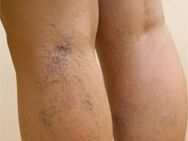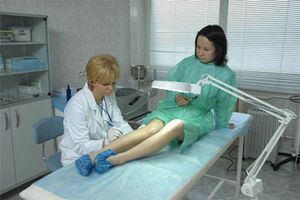
Varicose veins (or varicose veins) on the legs are quite common. Most women between the ages of 30 and 60 suffer from it, especially if they have diabetes mellitus or are overweight and have posture problems. In addition, these people suffer from varicose veins, the work of which requires them to stand or sit for a long time. Unfortunately, the number of cases is increasing every year. That is why it is important to know not only how to cure varicose veins on the legs, but also how to avoid them.
Reasons
Treatment of varicose veins, first of all, should be to eliminate the immediate cause of its appearance. Here are the most common in everyday life:
- Standing or sitting for a long time;
- Overweight (obese);
- Increased pressure in the veins of the lower extremities due to high loads with constipation, bodybuilding and pregnancy;
- Congenital or post-traumatic absence of venous valves in the vessels of the lower limbs.
It is possible to cure varicose veins on the legs only after eliminating all of the above factors. Otherwise, relapses of the disease cannot be avoided.
Symptoms
One of the most important signs of varicose veins is the appearance of swelling and lumpy swelling along the veins of the lower extremities. Often this is accompanied by severe pain and heaviness in the legs, an unpleasant burning sensation may be added. In severe cases, episodic cramps and edemas in the legs may occur, which, as a rule, appear in the late afternoon. A hallmark of varicose veins is the gradual thickening and darkening of the skin on the leg.
If left untreated, the walls of the affected vessels become inflamed and blocked with multiple blood clots. Over time, ulcers can develop on the skin. In the overwhelming majority of cases, such a development of events leads to quite formidable diseases, for example, thrombophlebitis or thrombosis.
When should you see a doctor?
Varicose veins develop gradually, but sometimes they progress quite quickly - in such cases you can not hesitate to consult a doctor. For the acute course of the disease, the following symptoms are characteristic:
- Sharp pain that reaches an intensity such that a person cannot move independently. This is accompanied by a feeling of heat and hardening of the skin on the legs;
- Shortness of breath, feeling weak and short of breath;
- Localized bleeding in the immediate vicinity of the affected venous vessels or themselves.
Diagnostics
When the first signs of varicose veins appear, you should seek help from your doctor. As a rule, after carrying out standard examinations (examination, history, OAC, OAM), he or she refers these patients to a specialist in vascular diseases (phlebologist) or immediately to a vascular surgeon.
In addition to basic diagnostic measurements, they can be assigned:
- venous ultrasound (double-sided scan);
- Contrast venography.
Processing
Today there is no cure for varicose veins, which would give 100% result. Treatment should be carried out comprehensively using both surgical and therapeutic techniques.

Conservative treatment
The fight against varicose veins in the legs with the help of conservative methods is possible only in cases when the symptoms are just starting to appear and it is not necessary to talk about possible complications. The main components of this treatment are:
- Diet;
- A set of special exercises;
- Compression therapy;
- Drug treatment.
Diet
As mentioned earlier, varicose veins mainly affect overweight people. In this regard, one of the conditions for successful treatment is undoubtedly compliance with the correct diet, aimed at destroying extra pounds. There are many variations on how to prepare your daily diet, but none of them should be followed without first consulting a dietitian.
As a general rule, such diets involve avoiding sweets, as well as foods that contain a high amount of plant fiber.
Physical fitness
Physical therapy exercises are an excellent remedy for varicose veins in the legs. There are a number of special exercises that can be performed to significantly slow the progression of the disease and sometimes get rid of it altogether. Don't forget to walk in the fresh air (morning and evening) and to swim.
Important!With varicose veins, you should refrain from going to the sauna, bathing, taking a too hot bath and not floating your feet. This is due to the fact that with these procedures the blood flow to the extremities is significantly increased, where with varicose veins its stagnation is already observed.
Compression therapy
Treatment of varicose veins at home involves the use of special suits in the form of golf, stockings and tights, as well as elastic bandages of different lengths. As a rule, doctors recommend that you wear them all day and only take them off before bed.
Thus, it is possible to significantly increase the tone of the veins and improve blood circulation in the legs. And this, in turn, helps to eliminate the symptoms of the disease. A foot massage for varicose veins is also very useful, which should be performed by a specialist.
Drug treatment
Today, drugs for the treatment of this disease are widely represented in the pharmaceutical market. In addition, together with the tablet forms, gel, ointment and cream for the legs against varicose veins are used. All of them can significantly reduce the rate of progression of the disease and even prevent the development of certain complications.
However, we must remember that any medicine should be used only as directed by a physician. Indeed, almost each of them has quite a few contraindications, and improper use can lead to unforeseen situations.
Most often, for varicose veins of the lower extremities, doctors prescribe drugs from the following groups:
- Anti-inflammatory drugs;
- Venotonics - drugs that help increase the tone of the veins and improve venous flow;
- Preparations to reduce the viscosity of the blood and prevent blood clots.
Surgical treatment
Surgery is the most radical method used in situations where all the alternative methods of struggle do not give any positive results.
The most common operation is to make small incisions in the skin and remove the affected veins through them. After the operation, the legs are well bandaged. After a few hours, patients can already move around independently.
Nowadays, a technique of removing pathologically altered veins using a laser is more and more widespread. Such an operation is less traumatic, but after it relapses of the disease are often observed.
Prevention
Without a doubt, like most modern diseases, varicose veins are easier to prevent than to cure. That is why doctors recommend starting the prevention of this disease from the first years. To do this, follow these steps:
- Be active in sport;
- During standing work, you need to periodically take breaks (walk on toes, then on heels);
- After exercise, you should take a cool shower;
- During pregnancy, especially in the later stages, special swimsuits should be worn.























